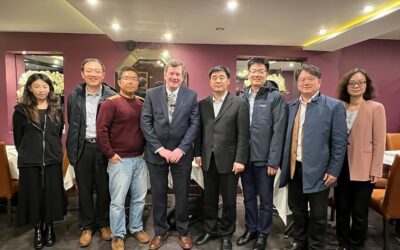Corrosion Science Symposium Report
The 61st Corrosion Science Symposium (CSS) was held online this year via Zoom between the 14th and 16th September. The CSS has been held annually since its launch in 1960 by Prof. L.L. Shreir, and is an ideal opportunity for students and younger researchers in corrosion science from across Europe to congregate, discuss their work, share ideas and, above all enjoy themselves in a stimulating/friendly environment. This year there were 17 oral presentations and the UR Evans award plenary talk.
Some highlights of the symposium included the talk by Mariana Folena (University of Leeds) who gave an interesting overview of her work studying rapid screen techniques for thiols as volatile corrosion inhibitors in real time monitoring carbon dioxide top-of-line corrosion. To date, no studies have been conducted to understand the efficiency of smaller thiol chains, nor the extent to which thiols partition into the condensate phase of the system. Mariana presented two new techniques to improve the understanding of the mechanism of volatile corrosion inhibitors; a biochemical method to quantify sulphydryl groups, and a miniature electrode cell configuration for real time corrosion monitoring and quantification of inhibitor adsorption kinetics. The new assay is rapid, cheap and can monitor the extent to which thiol-based chemistries partition into the condensate.
David Ruis-Izuriaga (University of Manchester) reported on his studies using near ambient pressure X-ray photoelectron spectroscopy (NAP-XPS) to gain insights into sweet (carbon dioxide) corrosion mechanisms. Specifically, the NAP-XPS has been utilised to study in situ the interaction of carbon dioxide and water with an iron substrate.
Anastasija Lazareva (University of Leeds) gave a good overview into recent new insights into the initiation and propagation of localised corrosion of X65 pipeline steel in sweet corrosion in the presence of an evolving iron carbonate layer. Anastasija found that localised corrosion initiation takes place at the early stages of iron carbonate evolution and propagates further when full coverage of the carbonate surface is achieved.
The UR Evans award plenary talk was given by Prof Robert Cottis from the University of Manchester. The UR Evans Award is the Institute’s premier scientific award and is awarded annually in recognition of outstanding contributions to corrosion science and engineering. The award is in the form of an engraved sword and is presented at the annual Corrosion Science Symposium. The form of the Award symbolises the fight in which we are all engaged. Prof Cottis gave a detailed personal reflection of electrochemical noise – what is it and what it can tell us. He reviewed its history to study corrosion over the past 50 years, and highlighted that it still remains unclear whether there are generic interpretation methods that can provide useful information. The plenary elegantly introduced the various measurement methods of the technique, considered some of the source of noise, including the noise due to individual elementary reactions, pitting corrosion, bubble evolution, and turbulent flow. From these theoretical approaches the interpretation of the electrochemical noise was developed. Prof Cottis concluded by discussing the broad range of heuristic methods that have been developed and commented on their applicability.
The Shreir Prize is awarded to the best oral presentation by a registered student at the CSS. This year the prize was won by Christos Kousis (Swansea University) for his talk entitled ‘An investigation of the effect of chloride ion concentration on the localised corrosion of the E717 Mg alloy’. Christos gave an insightful talk on using an in situ scanning vibrating electrode technique, coupled with time-lapse imaging, to study E717 Mg corrosion behaviour. The intensity of the localised anodes is highly dependent on the chloride ion concentration, where higher anodic current density values are observed with increasing chloride ion concentration. In addition, volumetrically-determined hydrogen evolution rate is also shown to increase with increasing chloride concentration. Christos was able to utilise his imaging methods to effectively highlight the underlying mechanistic processes with good clarity.
The 62nd CSS will be a joint meeting with Advances in Corrosion Protection by Organic Coatings to be held in Cambridge (Christs’ College) between the 5th and 9th September 2021. Further details on registration and abstract submission will be announced shortly.


